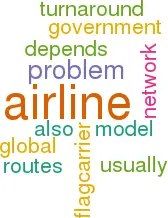Flag-carrier rescues: Some issues
September 2014


The fundamental problem that governments have when setting out to rescue their flag-carriers is that they have only a vague, political idea of what role the airline should be playing. Typical non-commercial aims under full or part government ownership are to:
-
Assure links between the capital and regional points within the country
-
Maintain region politico-economic balance against flag-carriers of nearby countries
-
Promote a global presence to reinforce economic growth
-
To maintain what is still a national symbol.
In a rescue situation there is only one aim: to make the airline commercial. The menu of reforms varies from airline to airline but usually contains these elements.
-
New Management. Successful airline managers are generally creative types who are driven to grow their company and deliver profits. However, the turnaround role involves destruction, brutal negotiation and somehow managing political expectations, requiring a different type of executive.
-
Network Rationalisation. The concept is simple: quantify the losses on a route by route basis (more complicated for a hub network than a point-to-point operation but perfectly feasible), identify the loss-making routes at various levels of contribution or profitability and cull them starting with the most hopeless and stopping with the marginally hopeful. The big problem arises when there are so many unprofitable routes that cutting them redistributes fixed costs to the profitable routes sending them into loss.
-
Fleet Restructuring. The feasibility of disposing of surplus capacity depends the degree of debt associated with the fleet (usually very high if the airline has reached this point) and willingness of banks and lessors to renegotiate (it helps if local financial institutions, the government and the airline are closely bound up together – the JAL situation). There is the danger that if too much capacity is cut, the operational efficiency of sub-fleets is compromised – MAS’s A380 problem. Selling aircraft also requires there to be second-hand demand — also MAS’s A380 problem.
-
Sale of Subsidiaries This may seem to be a relatively painless way of raising cash. But it frequently turns out that the maintenance or catering subsidiary’s apparent profitability actual depends on contracts with the flag-carrier.
-
Reduction in Workforce. Involuntary rather than voluntary lay-offs are preferable in order to retain the most productive employees, but this may not be politically palatable. One solution for the turnaround team is to make this the government’s problem. The Greek government guaranteed all of Olympic’s employees not only generous redundancy terms but also jobs in other parts of the public sector (or course Greece ended up in de facto bankruptcy).
Assuming the turn-around works, what airline model replaces the flag-carrier model? It depends on the geography and the economy. Air France became a global network carrier because it was based at Paris (but has clearly not shaken of its flag-carrier legacy). Usually, the result is a hybrid type model – Swiss out of Swissair’s subsidiary, Crossair; SN Brussels out of Sabena’s subsidiary, DAT – viable, smallish airlines that then can be taken over by a global network carrier, Lufthansa in this case.